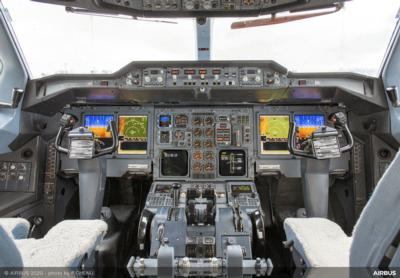Wed, Feb 10, 2021
Upgrades For UPS Airlines’ Fleet of 52 A300-600 Freighters Underway
Airbus has handed over the first completed cockpit upgrade for UPS Airlines’ fleet of 52 A300-600 Freighters.

The aircraft (MSN868), equipped with Honeywell cockpit avionics, was redelivered to UPS on 3rd February at Airbus’ U.S. facility in Mobile Alabama following the certification by EASA on 22nd December 2020 and by the FAA on 5th January 2021. This is the first time that such a complex upgrade has been performed on the A300. UPS expects to have the entire fleet converted by peak season of 2022.
The enhancements transform the A300-600 cockpit to confer the maximum operational flexibility and capabilities – bringing it close to current generation of aircraft. Key to achieving this is the advanced new integrated avionics system supplied by Honeywell, which is based on its Primus Epic suite.
The four large 10x8 inch LCD main displays and the new colour multi-function control & display unit (MCDU), which replace several analogue instruments, are the most immediately visible changes to grace the A300-600’s upgraded instrument panel. Other new ‘under the hood’ items include: a new flight management system (FMS); support for a worldwide navigation database; a new multi-mode receiver (MMR) incorporating the latest GPS-based satellite navigation systems; a digital datalink for communications with air traffic control (ATC); a central maintenance computer; and a digital weather radar system with turbulence detection and windshear prediction – among numerous other capabilities.

The upgrade also provided the opportunity to integrate several enhanced safety and situational awareness functions.
These include the latest Enhanced Ground Proximity Warning System (EGPWS), fully integrated traffic collision avoidance (TCAS) functions, a vertical situation display and a new GPS-based instrument approach capability which is a valuable aid for pilots when flying to airports that are not equipped with traditional radio-based ILS equipment.
More News
Aero Linx: The American Society of Aerospace Medicine Specialists (ASAMS) The Society is a non-profit organization created to serve as a voice for and represent the professional ne>[...]
Class C Service This service provides, in addition to basic radar service, approved separation between IFR and VFR aircraft, and sequencing of VFR aircraft, and sequencing of VFR a>[...]
Have A Story That NEEDS To Be Featured On Aero-News? Here’s How To Submit A Story To Our Team Some of the greatest new stories ANN has ever covered have been submitted by our>[...]
Also: ERAU Uses UAVs, P550 Group 2 UAS, Starship’s Florida Launches, NASA Missions Chopped The Air Force has put out a call to commission a one-to-one copy of the Iranian-des>[...]
Classic Klyde Morris From 11.07.16 (and Remembering Bob...) FMI: www.klydemorris.com>[...]
 ANN's Daily Aero-Linx (08.27.25)
ANN's Daily Aero-Linx (08.27.25) ANN's Daily Aero-Term (08.27.25): Class C Service
ANN's Daily Aero-Term (08.27.25): Class C Service ANN FAQ: Submit a News Story!
ANN FAQ: Submit a News Story! Airborne-NextGen 08.26.25: Iran UAV Knockoffs, X-37B Spaceplane, Army Training
Airborne-NextGen 08.26.25: Iran UAV Knockoffs, X-37B Spaceplane, Army Training Classic Klyde Morris (08.25.25)
Classic Klyde Morris (08.25.25)




